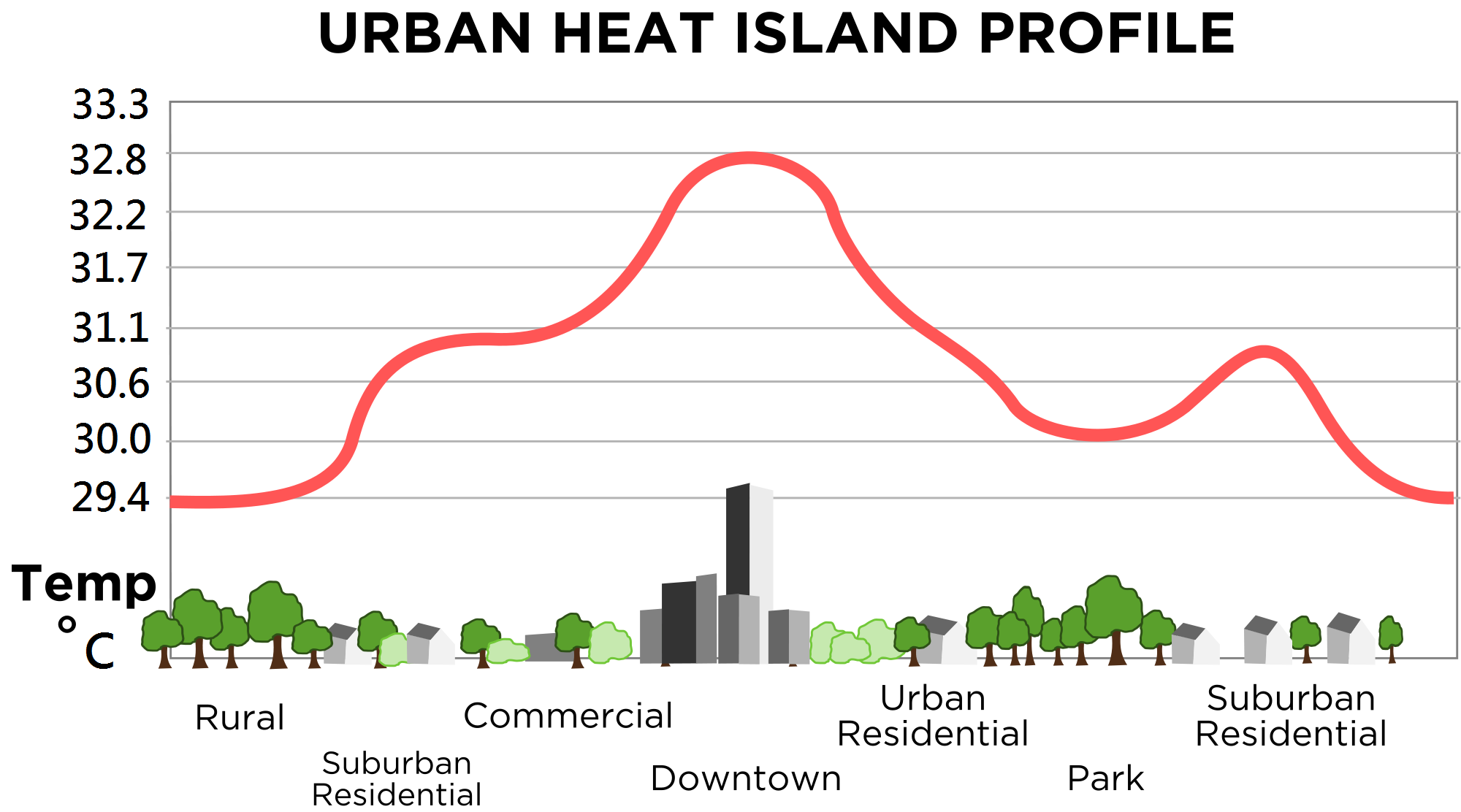The Urban Heat Island (UHI) is a phenomenon typically associated with urban areas, and is defined as a temperature difference between urban and rural areas, caused by the excess of emitted heat and by the solar gain trapped by the urbanized environment.
Urban heat islands result from the use of heat-absorbing building materials such as metal, concrete, and brick, as well as a scarcity of vegetation that reduces cooling through evaporation and transpiration. Additionally, human activities such as transportation, lighting, and air conditioning actively contribute to trapping heat.

As reported by the BMJ, the UHI effect can impact on human health both directly and indirectly. Extreme heat has a direct effect on mortality and morbidity, usually leading to more severe consequences for vulnerable populations, such as the elderly or those on low incomes, which are often concentrated in urban areas where the heat island effect is highest.
For this reason, people who live in cities are usually more affected by extremely high temperatures or heat waves compared to people who live in suburban or rural areas.
Moreover, some neighborhoods within a city can be hotter than others because of an uneven, inequitable distribution of cooler spaces with vegetation or water in the urban landscape. This creates a patchy, non-uniform map of the impacts of heat on human life and wellbeing.
The intersection of increased heat island conditions and demographic inequities amplifies additional heat-related risk factors. For example, air quality tends to deteriorate on hot, sunny days: sunlight reacts with air pollutants, leading to increased ground-level ozone, or smog. As reported by the United States Environmental Protection Agency (EPA), for example, several studies in the United States show that certain communities of color and low-income households are more susceptible to asthma compared to the general population, exposing them to higher risks from elevated temperatures, air pollution, and the smog formed under such conditions.
Moreover, extreme heat can create financial stress on low-income families, who also usually live in less energy-efficient homes, that require a higher energy and financial effort to be cooled down.
Health inequalities
“As epidemiologists, we use health inequalities as one of the most efficient metrics to identify criticalities,” says Giuseppe Costa, Emeritus Professor at the Department of Clinical and Biological Sciences of University of Turin. “Every time we observe, monitor, and study health-related phenomena, we look out for differences and disparities, because they can indicate that certain individuals or groups have achieved better health outcomes, thus highlighting the potential for improved healthcare quality and prevention strategies.”
While other factors such as gender and disability also contribute to disparities, it is the social and geographical differences that best explain health inequalities and therefore are most capable of revealing potentially avoidable problems. Moreover, geographical disparities often align with social disparities due to the tendency for socioeconomically disadvantaged individuals or culturally homogeneous communities to cluster in specific neighborhoods or districts.
“By addressing these differences, we can work towards reducing health disparities and creating equitable health outcomes for all,” says Costa, “and at the urban level all these dynamics are more enhanced, because the segregation mechanisms are usually stronger in cities. The interdependence between geographical and social factors is therefore also a key driver of the impacts on health of the Urban Heat Island effect.”
UHI can be particularly concentrated in suburban neighborhoods, but the main reason why heat islands have an adverse effect on people’s health is that residents of more disadvantaged urban areas usually have specific clinical susceptibilities, for example to chronic diseases that are particularly sensitive to thermal stress. “Therefore, it is not solely the heat island itself that is concentrated in the poorest areas,” says Costa. “While this can certainly happen, it is the vulnerable individuals who are particularly concentrated in certain areas, and this is the main reason why we are concerned about this aspect. Prevention and mitigation interventions, whether structural, social, or healthcare-related, must refer to this mapping of vulnerability and social factors to target those who are more susceptible to harm during extreme events such as heatwaves.”
Vulnerability to heat and climate-related risks can therefore refer to two concepts: clinical vulnerability, or fragility, refers to the susceptibility of individuals with certain health conditions that make them more prone to suffering from extreme climate events. Social vulnerability, on the other hand, refers to the difficulty of having access to facilities that can protect from the extreme temperatures, such as air conditioning or proper ventilation, or to support networks that can provide assistance or care.
Climate change and global warming are causing more frequent and intense heat-related disasters, resulting in higher risks for the health and more fatalities. For instance, the 2003 heatwave in Europe led to around 70,000 excess deaths, while the 2018 heatwaves in Japan resulted in over 20,000 hospital admissions related to heat stroke, mostly in older people, as reported by the BMJ. Higher temperatures and air pollutants also contribute to cardiovascular and respiratory health issues. Urban heat exposure is linked to kidney disease, mental illness, reduced labor productivity, and strain on healthcare systems, particularly in developing countries.
“Scientific evidence shows that the most evident impact of climate change on health, at least in Italy and Europe, is due to the Urban Heat Island effect,” says Costa. “Its effects are actually quite alarming, because they affect fragile and more vulnerable groups particularly hard. It almost looks like a small-scale pandemic.”
Effective strategies to address heat inequity
The magnitude of heat-related health risks depends on climate hazards, individual vulnerability, and adaptation measures. Effective emission reductions and adaptation can significantly mitigate the negative health impacts of climate change.
Addressing heat inequities involves implementing programs and policies specifically aimed at historically marginalized and disadvantaged people to diminish their disproportionate vulnerability to heat-related risks.
As suggested by EPA, efficient strategies to resolve heat inequity can include: engaging communities in decision-making processes; ensuring that relevant information reaches residents efficiently and engagingly; incorporating principles of environmental justice, such as directing increased public investments towards underserved neighborhoods; designing and promoting programs to benefit energetic efficiency of residential buildings.
“Strategies that have been proven to be more effective are structural ones,” says Costa. “If the living environment can be effectively air-conditioned, protection against heatwaves is ensured. This is what happened, for example, in Turin after the 2003 heatwave. The main intervention carried out by the local administration after that extreme event was to promote and support an increased distribution of air-conditioning in nursing homes and assisted living facilities. Data of the effects of summer heatwaves on mortality for the following years showed that the excess mortality among elderly individuals continued unaltered for those residing at home, while it almost disappeared among the elderly people residing in nursing homes.”
Other effective strategies are represented by the setting up of alarm mechanisms, aimed at informing citizens and social actors about the potential severity of a heatwave a few days in advance, thus triggering corrective and mitigating measures that can be crucial in saving lives and lowering the pressure on the healthcare system.
In this context, it is then crucial to collect relevant data, and map critical situations and potential solutions. For example, identifying and tracking the most intense UHIs in a city and the areas with a higher concentration of vulnerable residents can be crucial for local administrations to design equitable heat solutions.
An interdisciplinary study published in the Urban Climate journal and led by the CMCC Foundation focuses on the Urban Heat Island phenomenon, providing a reproducible and flexible methodology to explore the risk assessment on the heat-health nexus within the city of Turin, Italy.
“The UHI phenomenon is typical of urban areas and it is stronger during heat waves events,” said Marta Ellena, of the CMCC’s REgional Models and geo-Hydrological Impacts (REMHI) division, and first author of the paper. “This happens because cities are mostly covered by impermeable surfaces, and this makes temperatures higher, worsening the already existing UHI effect.”

The main objective of the study was to produce climate risk assessment evaluations at the local scale taking under consideration the main drivers of inequality, which are crucial for suggesting adaptation strategies for more climate-resilient and sustainable cities.
“The combination of different factors allows us to express the complexity of the concept of risk associated with Urban Heat Islands,” said Guglielmo Ricciardi, of CMCC and Politecnico di Torino, another author of the study. “It’s not only greener or more urbanized areas that influence the risk on citizens. We should also consider the characteristics of buildings, the proximity to hospitals, or to public spaces with air conditioning, among others.”
The impact of the urban environment on human health is a topic which is gaining growing relevance and credibility at a scientific level. Moreover, climate change and the UHI effect are both phenomena that are increasingly affecting human life, and are mutually reinforcing each other, leading to expected higher heat-related risks in the future.
“In the last 15 years, a fast-growing number of studies focussed on the importance of urban green areas for human health,” says Giulia Melis of Links Foundation, “but the impacts of the urban landscape on people are also social, and from a health point of view, this points to health inequalities.”
Future climate-resilient cities
In urban areas, inequalities often derive from a dishomogeneous distribution of facilities and services. The availability of an efficient public transport system and of basic services in a neighbourhood contributes to improving the quality of life of its inhabitants.
“In Italian cities, on average, the main climate-related problems are heat waves and floodings,” says Melis, “and, as a result, local administrations are starting to think about strategies and solutions to face these risks and reduce their impacts. Identifying priority areas for action for climate risk and population vulnerability and mapping places that can act as safety hubs for vulnerable people can help with finding the most effective solutions.”
Creating a climate resilient and safe urban environment is a transversal and intersectoral effort, as it involves several fields of expertise and intervention. This concept is at the core of the Rockefeller Foundation’s “100 Resilient Cities” programme, aimed at finding strategies to tackle the physical, social, and economic challenges of modern cities.
According to this framework, urban resilience could be achieved by following a roadmap that encompasses concrete actions, strategies, and initiatives, and emphasizes exchange and collaboration among stakeholders in diverse factors such as air quality, green spaces, urban regeneration, mobility, public transport, welfare, and health.
“I think that the future climate-resilient cities should definitely be greener, and obviously have more public spaces, more cycle lanes and more energy efficient buildings.” says Melis. “But I think that the social aspect is extremely important. The participation of citizens in taking care of their neighbourhoods, their cities and their fellow citizens is crucial to create resilient communities that are at the heart of a sustainable and safer urban space. And this cooperation and social ties are definitely facilitated by the urban environment itself, which should be designed in a way to draw people towards sharing and enriching public spaces.”






